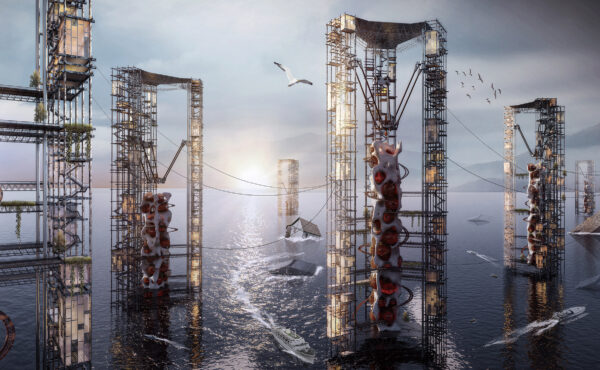Honorable Mention
2023 Skyscraper Competition
Di Zhang, Enda Zhou, Qi Wang, Yu Wang, Ruobing Du, Hanwen Huang
China
Our quality of life today has been greatly improved compared to before, and what people pursue is no longer limited to food and clothing. With the improvement of the quality of life and the promotion of network technology, our life has become colorful. People can use different ways to express their feelings, art, or self, and they also have diversified channels to ensure their living standards are richer. But it also has many negative impacts on the planet we live on, among which global warming is the most worthy of people’s attention.
There are many factors that lead to global warming, such as regional wars, deforestation, irregular gas emissions, excessive animal husbandry, excessive non-recyclable items, etc., that will aggravate the pace of global warming. Over the past 150 years, temperatures have accelerated over time to the extent that they contribute to sea level rise. Fiji is facing this huge conundrum. In the next 20 years, continuous sea level rise will affect the survival and living of 570 cities and 8 million people. Half of our land will disappear in 500 years, which will be a disaster for all living things on earth.
The word “greed” may be the culprit of global warming. For example, some nuclear-armed countries bully weaker countries at all costs for their own interests. Missiles and phosphorus bombs destroyed and burned urban facilities, buildings, and greenery. Some countries accelerate deforestation and mine ore for profit. There are also some countries that are preparing to discharge nuclear wastewater into the ocean.
The world has come to this point, “What can we leave for future generations?” has become the direction of our thinking. We seek fast, efficient, functional, and adaptable 3D printing with a fast functional conversion The house uses the main secretions of corals, the dead bodies of marine organisms, or decomposed garbage as printing materials to print and build our future living space. Materials can not only provide space for terrestrial organisms to live in, but also help marine organisms inhabit. We call the printed body a coral skeleton and then combine PLA with materials such as natural rubber and coral powder to construct multiple spherical living spaces and put them in the coral skeleton to form a symbiotic living environment for humans and animals. During the printing process, people are arranged to live in boxes on the three sides of the printer, which will make a transition in people’s lives. After the printing is completed, it is decided whether to recycle the shelf according to the regional situation and population density, so as to ensure the stability of the life of local residents. Satisfied to the greatest extent with low cost, low energy consumption, green energy saving, and high quality of life for people to live in. The design is named Land Printing for the future to warn people to pay attention to environmental protection, and to make full preparations for future accidents, hoping that people can return to land as soon as possible on that day.
To sum up, the various environments of global warming are almost inseparable from the presence of human beings. Finding a peaceful way to resolve conflicts and jointly create a sustainable and stable economic system may help reduce global warming factors. Although the concept of 3D printing high-rise sustainable buildings has been designed and proposed by us, we sincerely hope that there will be no such day in the future.

















